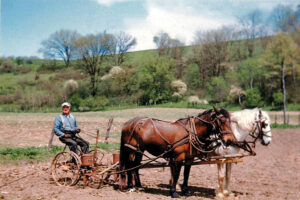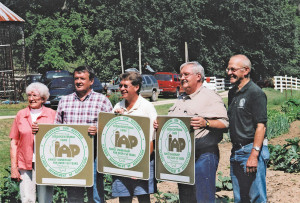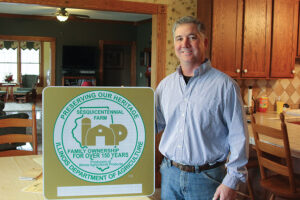 “And on the eighth day, God looked down on his planned paradise and said, “I need a caretaker.” So God made a farmer.
“And on the eighth day, God looked down on his planned paradise and said, “I need a caretaker.” So God made a farmer.
God said, “I need somebody willing to get up before dawn, milk cows, work all day in the field, milk cows again, eat supper, then go to town and stay past midnight at a meeting of the school board.” So God made a farmer.
God said, “I need somebody willing to sit up all night with a newborn colt and watch it die, then dry his eyes and say, ‘Maybe next year,’ I need somebody who can shape an ax handle from an ash tree, shoe a horse with a hunk of car tire, who can make a harness out of hay wire, feed sacks and shoe scraps. Who, during planting time and harvest season will finish his 40-hour week by Tuesday noon and then, paining from tractor back, put in another 72 hours.” So God made the farmer.
-excerpt from Radio Broadcaster Paul Harvey’s address to the 1978 FFA convention
Family farms have long been part of the fiber of Illinois. In fact, according to the Illinois Department of Agriculture, more than 600 farms are officially registered in Illinois as sesquicentennial farms and more than 9,200 have the centennial designation.
These farms can be found from the northern border to far south Dongola and all points in between. The official signs may be posted at the gates or just kept close to the heart but either way are a testimony to Illinois’ rich agricultural heritage.
Cooperative roots

In 1854 the Dittmar family came to the United States from Germany to avoid the mandatory three-year service in the German Army being imposed upon their sons by the new Prussian government. The majority of the Dittmars settled in an area in southeastern Jo Daviess County, which they named Massbach after their family village in the old country. Erhardt Dittmar originally tried to settle near Shullsburg, Wisc.; he didn’t like the rolling prairie there, and instead found unique acreage south of Schapville and north of Elizabeth.
Erhardt Dittmar bought the original 160 acres for 50 cents per acre from the Illinois Central railroad and passed it down to his son, Erhardt II. Third generation patriarch, Henry Dittmar, was a Jo Daviess Farm Bureau director and one of the original incorporating directors of Jo-Carroll Energy. His signature can be found on the cooperative’s original charter. He saw the need for electricity in the rural areas and was very forward-thinking as far as technology was concerned.
Henry’s son, Delmar, was also very involved in the community. He served on the local school board and was a big proponent of the cooperative. That support for Jo-Carroll Energy, and the community in general, carried through to the following generations.
On the original farm they raised hogs and both dairy and beef cattle along with the corn and alfalfa it took to feed them. Hogs were an important part of the farm, both because the meat was easily smoked to preserve it and the lard was used for cooking and making soap. It was common to let hogs run loose in the pasture to allow them to forage for food.
Six generations and 159 years later, the farm now belongs to Delmar’s sons Richard, Robert and Steven, along with Richard’s son, Michael. Richard and Michael operate the farm and still raise a few cattle and plant corn and alfalfa for the livestock. They have also branched out into a few specialty crops – sweet corn, pumpkins and apples.
The farmhouse, built in 1906, still stands today, and 90-year-old grandmother, Rita, lives there. Michael Dittmar is working hard to make upgrades to the farm and foster his children’s interest in it. “I want my kids to learn a good work ethic,” says Michael. “The farm does that.”
There is co-op history and legacy in the Dittmar family. Merri (Dittmar) Sevey is the vice president of human resources at Jo-Carroll Energy and says, “My grandfather Delmar firmly believed if it wasn’t for the co-ops, they would have still been using kerosene lamps. The investor-owned utilities thought farmers would have a light in the barn and two in the house and that would be it. My Grandmother Rita said Grandpa would have been very proud that I’m employed by the co-op.”
A southern view

In far southern Illinois sits the sesquicentennial farm of Randy Mead. In the family for six generations, it was originally purchased in 1841 by his 4th Great-Grandfather Peter Rymer. The original 80 acres was passed down through the generations, and an additional 140 acres was purchased along the way. The 220-acre farm sits in rural Dongola and is being used much the same way it was more than 150 years ago. Mead has the original land purchase documents signed by President Andrew Jackson.
Mead still raises cattle and cuts hay to feed the animals, just like his predecessors. His 102-year-old grandmother, Alva Dillow, tells the story of how electricity was coming to their area and she was saving her money to get hooked to it. When her husband wouldn’t agree to get electricity on the farm she moved into town. That only lasted two days and then her husband moved into town also. He never did hook up electricity on the farm, and they never moved back out onto it.
Outside his dining room window, Mead can look onto the lush, green rolling hills that were once the original farm. He wants to be able to pass this land on to his family, just as those before him did.
All in the family


Brothers Walt and Charles Lewis of rural Blandinsville farm 100 acres of the land their Great, Great Grandfather John B. Eakle purchased in 1852. Originally military tracts, Eakle bought 400 acres from the Colgate family who had speculated on the land and decided to return to New York.
Walt and his wife, Gayla, have two sons, Ross and Philip, and live on 100 acres in the 1907 house built for Harvey Eackle. Charles lives nearby and the brothers farm corn and beans, and up until a year ago raised livestock as well. They say their grandfather believed “the only way to sell the grain was to walk it off the farm on the hoof.” The farm was self-sufficient in that regard.
The farm was passed down to their grandmother and then their mother. The family was hit pretty hard during the Depression, and their parents had to scramble to pay a huge inheritance tax bill in 1967, but the land survived. It is officially a Centennial Farm as designated by the Illinois Department of Agriculture and would also qualify as a sesquicentennial farm.
The rural Friendship Cemetery sits on their land and most of the family is buried there. They take care of it so that it doesn’t fall apart and disappear into the weeds, as often happens to family plots.
Charles has never been married and has no children. Walt is hopeful Philip, who is studying ag-business, will eventually come back to the farm. The brothers have also been purchasing adjoining land that was originally in the family as it becomes available. When asked why, Walt responds, “It’s heritage. It’s nice to have it back in the family.”
To learn about certification requirements to register your family farm contact the IDOA at 217-782-6675 or centfarms@agr.state.il.us.









